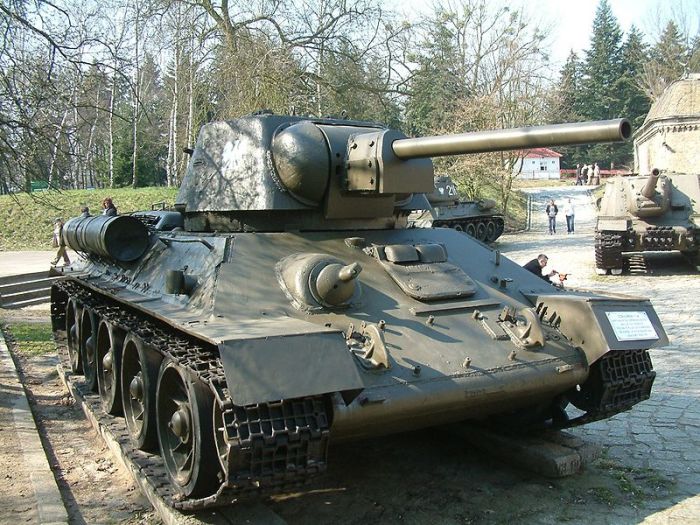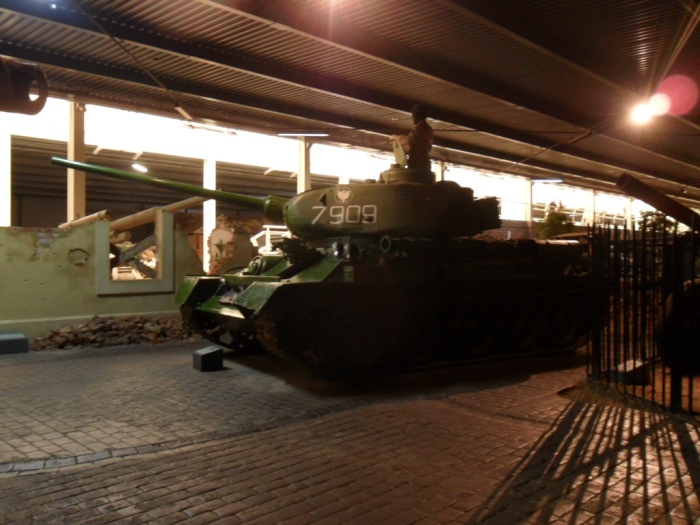I am well familiar with Mies van der Rohe’s beloved phrase less is more– and most of the time, I agree with it. But not today. Today I am writing about the Soviet T-34 tank of World War II; a tank which I believe was so accomplished and amazing that it deserves no shortage of attention. Only a plethora of photographs and in-depth analysis of this tank can appropriately honour its greatness and its critical victories on the Eastern Front. The T-34 is my favourite tank of all time, and this post is my homage to it.
When the Wehrmacht invaded the Soviet Union in late June 1941, it expected a quick and easy victory. Nazi Germany saw the Slavic race and the Soviet Union’s communist government as backwards and inferior, especially when compared to its own idealized Aryan soldiers and technologically advanced, well-equipped military. And in the first few months of the war, imminent victory didn’t seem too far-fetched; the Wehrmacht made enormous territorial gains while killing hundreds of thousands of Soviet soldiers. However, there was one surprise awaiting the Germans which eventually did erode their supremacy. That inconvenient surprise was the T-34.
A Czech T-34/85, seen at the Imperial War Museum in London. This was the first T-34 I ever saw
Most Soviet tanks in 1941 were obsolete, thinly-armoured, and quite terrible. In fact, the T-34 came about because the Spanish Civil War proved the sorry state of current vehicles like the T-26 infantry tank and the BT-7 cavalry tank. Masterminded by an engineer named Mikhail Ilyich Koshkin, the T-34 was designed with heavier armour, a better gun, impressive speed, and rugged construction.
The T-34 was fitted with a V-12 engine producing 500 horsepower. This enabled a top speed of 34 miles per hour. Image from Wikimedia Commons, attributed to Balcer
Great care and attention was given to T-34 production before war broke out; after June, however, the luxury of such care was no longer an option and tanks were simply assembled as quickly as possible. Attribution: RIA Novosti archive, image #1274/RIA Novosti/CC-BY-SA 3.0
It didn’t take long for the Wehrmacht to encounter the T-34/76; and when it did, the general reaction was one of shock and alarm. The widely-used Pak 36 anti-tank gun was completely unable to pierce the T-34’s ingenious sloped armour, and thus its German operators named their gun “the door-knocker”. The Wehrmacht’s medium tanks (the Panzer III and Panzer IV) also struggled against the T-34; which, with its balanced mixture of speed, armour, and firepower, seemed at times unstoppable. Field Marshal von Kleist, commanding panzers with Army Group South, called the T-34 “the finest tank in the world.”
Diagram of the T-34’s sloped armour, showing the extent of this important attribute. Image from Wikimedia Commons, attributed to BVV. CC-BY-SA 3.0
However, the T-34 force (like every other area of the Red Army in 1941) did suffer heavy losses. Unfortunately, around half of these losses were due to things like mechanical failure or running out of fuel instead of defeat at the hands of the enemy. Most sources put the early-war Soviet tank losses at 6 to 1, which is immense especially given the size of the Red Army’s tank force.
German forces were able to destroy T-34s by shooting their tracks or by air or artillery strikes. Attribution: Bundesarchiv, B145 Bild-F016221-0016/CC-BY-SA
These captured T-34s must have brought great relief to their new owners. Attribution: Bundesarchiv, Bild 101I-277-0836-04/Jacob/CC-BY-SA
Other factors also contributed to the inability of what was a vastly superior tank to halt the German onslaught in 1941. Some of these issues were down to ergonomics, while others were due to poor construction and the unready state of the Soviet Union upon Hitler’s invasion. One of the T-34’s greatest problems was its constricted 4-man turret. Most medium tanks (like the contemporary Panzer IV and famous Sherman) utilized a crew of five. The T-34’s more compact profile meant that only four men could be used, and this forced the tank commander to also aim the main gun- a major inconvenience in the heat of battle.
The cramped interior was only worsened by the widespread lack of training for tank crews. Some T-34 drivers had a few hours’ driving experience at best, and the T-34 was not the easiest tank to drive. Shrewd drivers often kept a mallet beside them because the controls could become jammed, and braking took extra effort because the transmission and gearbox were far apart. Furthermore, poor equipment such as a lack of radios meant that communication was achieved by signalling with flags through the turret hatch. The lack of training and difficulty in communicating make it hardly a surprise that Soviet tank attacks were usually just an unsophisticated mass charge.
A view through the driver’s hatch of a T-34/85. The T-34/85 appeared in 1943, with an enlarged turret allowing for an extra crew member. The cramped hull size, however, remained.
The panic of the invasion compromised craftsmanship at Soviet tank factories, which encouraged another flaw in the T-34. Many problems occurred with the gearbox in the field, which caused many otherwise perfectly good tanks to be abandoned. But at least the T-34 gave the Red Army some sort of advantage; and because of this, over 35,000 T-34/76s were built before the design was significantly changed in 1943. So crucial was the T-34 to the Soviet war effort, that stories abound of unpainted tanks being driven off the production line and straight into battle.
The T-34/76 ceased production when the T-34/85 came into being. With a bigger gun, thicker armour, and a comparatively roomy turret, the /85 collected lessons learned in the catastrophes of 1941 and created an even more formidable design. However, by this time, German panzer designers had also been working on design changes for their tanks; and the T-34 never regained the sizeable edge it had enjoyed earlier in the war.
The T-34/76 had a 76.2 mm main gun. Image from Wikimedia Commons, attributed to Radomil
The improved firepower of the T-34/85 came from an 85 mm gun, as seen in this photo from IWM Duxford
The battle which solidified the T-34’s greatness in battle against a better-prepared and more advanced German enemy was the Battle of Kursk in July 1943. This battle is legendary because of its gigantic scale and fierce tank warfare, and by the end of it the Soviet complement of T-34s had pushed back the panzers they had first faced two years before. Kursk ensured that the Red Army was now firmly on the offensive; and the Wehrmacht was defeated at its own game.
Another two years later, T-34s rolled triumphantly into Berlin. This unassuming, low-slung tank had taken the world by surprise, and embodied the spirit of the Red Army in World War II. No one would have chosen a little Soviet vehicle to beat all the panzers and anti-tank guns that the Wehrmacht was feared for. And against the mighty Wehrmacht, the Soviet Union was supposed to lose- but thanks to ingenuity and determination, it didn’t.
A proud T-34 stands guard at a Soviet war memorial in Berlin. Image from Wikimedia Commons, attributed to Drrcs15
The T-34’s service did not, however, end with WWII. Dozens of countries across Europe, Africa, and Asia have operated the T-34 post-WWII, and it has continued to feature even in 21st-century conflicts. Hardly surprising for a tank that, disregarding its easily-fixed problems, stunned the world and helped to win a war.
Countries in red have used the T-34 in the past. Current operators are in black, and recent are in pink. Image from Wikimedia Commons, attributed to Pgmail
This Bosnian Serb T-34/86 (seen in 1996) carries rubber sheets for extra protection. Image from Wikimedia Commons, attributed to Paalso
I love the T-34. And I prefer the T-34/76 variant, due to its simpler appearance and plucky spirit. I have such a deep admiration for this tank and for its crews that I am currently working on a trilogy of novels following a T-34 tank crew during WWII. I hope that after this post, more people will share my enthusiasm for this resilient tank, and have a greater idea of its part in WWII.
Soviet infantry advancing alongside T-34s near Orel, 1943. Image from Wikimedia Commons, attributed to Gallop
REFERENCES
(2014). T-34. Retrieved from en.wikipedia.org/wiki/T-34.
(2006). T34. Retrieved from http://www.historylearningsite.co.uk/t34_tank.htm
Zaloga, S.J. (2009). T-34/76 Medium Tank 1941-45. Oxford, UK: Osprey Publishing.













Leave a reply to aviationtrails Cancel reply